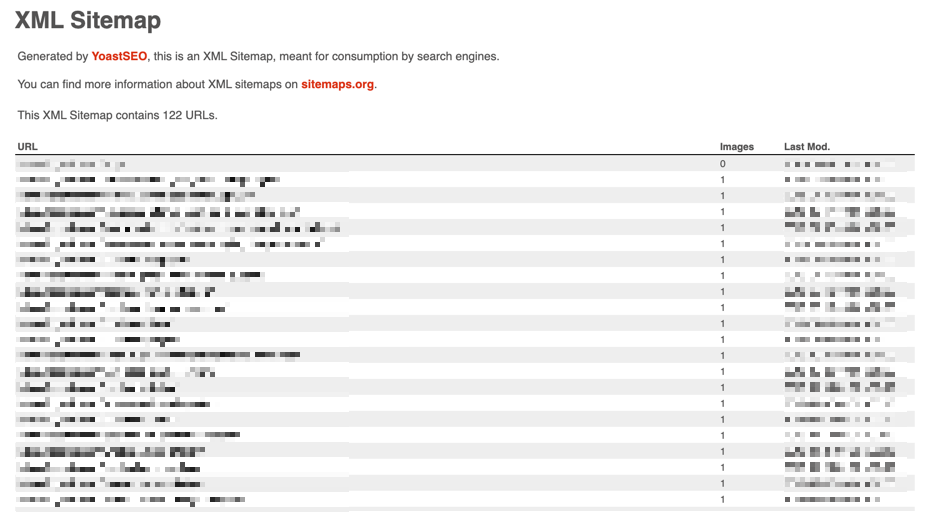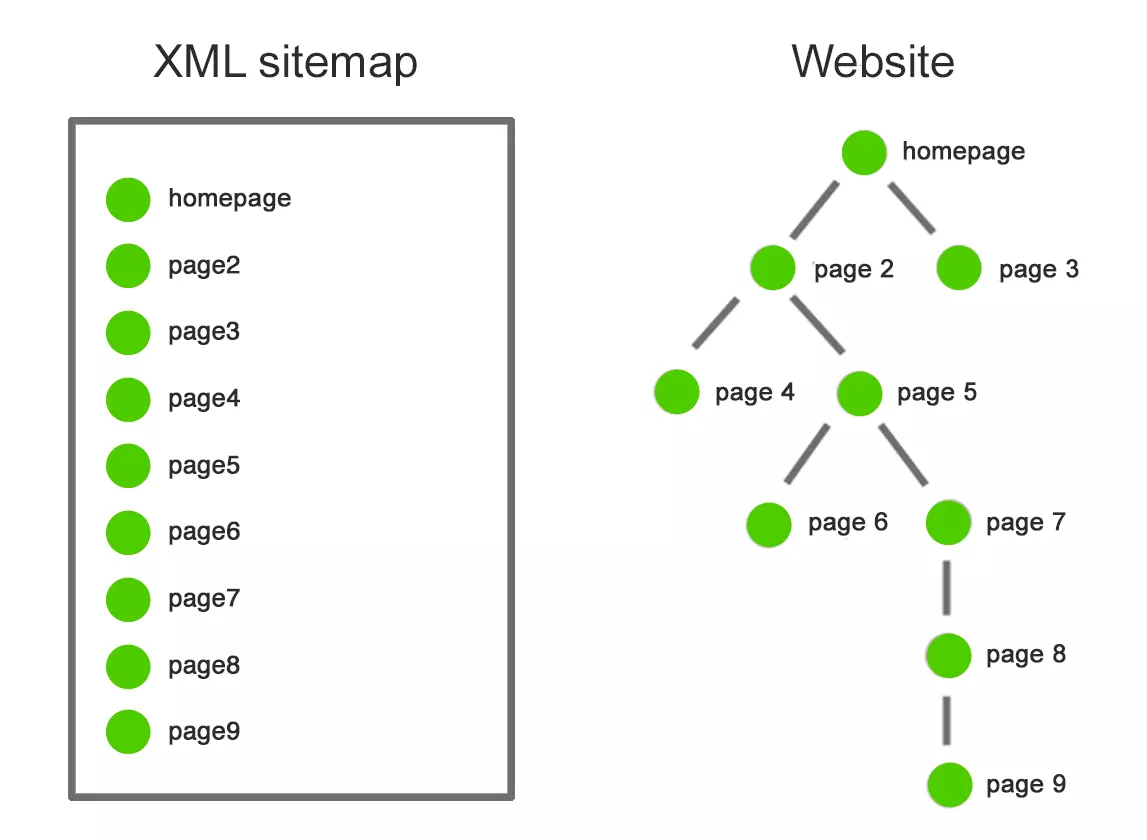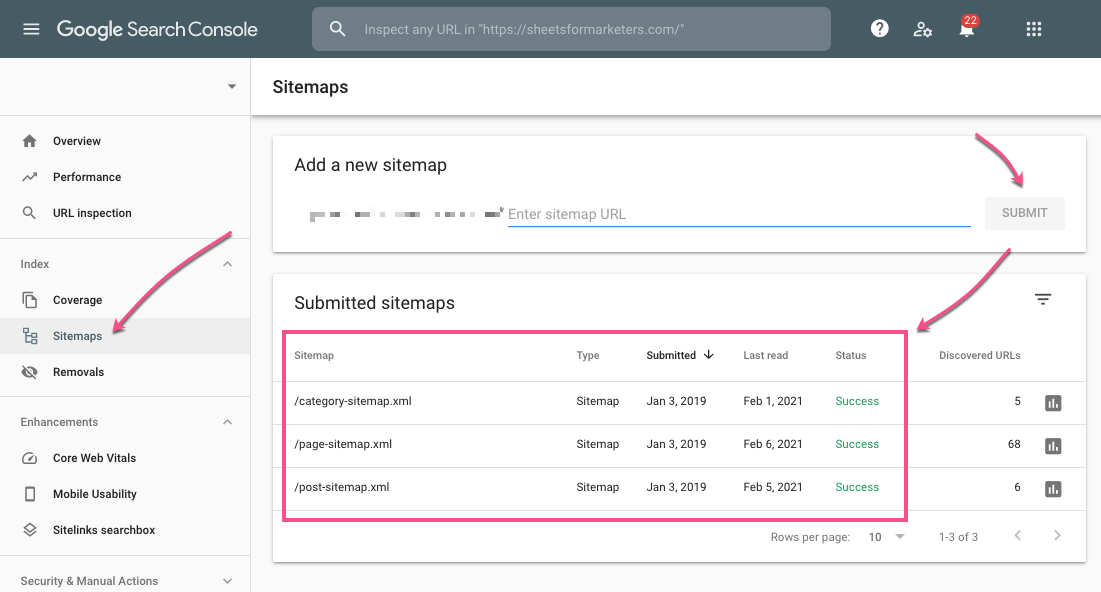What Are XML Sitemaps for SEO? (+ Best Practices)

Hand off the toughest tasks in SEO, PPC, and content without compromising quality
Explore ServicesImagine trying to find a place you’ve never been without a map or any instructions. Getting there would be pretty tricky, right?
You may be surprised to learn that search engines, as powerful as they may seem, suffer from the same problem. Luckily, there’s a way to put a “map”in their hands and point them in the right direction with a handy but oft-misunderstood tool called XML sitemaps.
Just what are they, and what is the significance of sitemaps for SEO? Do you need to create one for your website?
Today, we’re going to cover all of these questions and more. Keep reading to find out everything you need to know about XML sitemaps.
What Is an XML Sitemap?
Simply put, an XML sitemap is a list of all your website’s URLs. Think of it as a roadmap for telling search engines what content is available (and how to reach it).
An XML sitemap looks like this:

To understand what an XML sitemap is, you first have to know how search engines find pages.
They use bots, otherwise known as crawlers, to probe the web and find relevant results. And as anybody who has ever used a search engine has experienced, these crawlers are pretty good at quickly finding websites.

Source: https://www.searchenginejournal.com/technical-seo/xml-sitemaps/
Sometimes, however, the vast amount of content on the web slows them down and makes it difficult for the search engine to find a particular page on a website. This is where an XML (Extensible Markup Language) sitemap comes in.
What does an XML sitemap actually do?
An XML sitemap’s job is to tell search engine crawlers what they should look at on your site.
It’s essentially a text file that describes all the URLs on a website.
When created correctly, it makes for more efficient crawling, which means that search engines can find your pages more quickly. XML sitemaps help keep search engines updated of changes to your website—most notably when you add a new page or remove an old one.
They also may have extra info on each URL, like when they were last updated, their importance, and if other versions exist in different languages.
It’s important to keep in mind that creating an XML sitemap provides no guarantee that search engines will crawl and index your page.
However, having one is an excellent way to increase your chances, especially if your navigation or internal linking strategy doesn’t link to all of your pages.
What File Types Do XML Sitemaps Support?
Though HTML may be the first file type that comes to mind, what’s great about XML sitemaps is that they support several different file types.
You can adjust yours to include specific content on your site, such as:
- Video
- Image
- Mobile
- News
The content you want to target depends on what information you have on your site and what audience you hope to reach.
SEO Sitemap + SEO
By now, you’re probably wondering what effect XML sitemaps have on SEO.
Competition among websites is fierce these days, and unfortunately, SEO often falls short when it comes to outranking competitors.
Interestingly enough, you probably won’t run across XML sitemaps on a list of SEO best practices. Yet savvy website owners are now turning to them as a way to rank higher in search engines.
Why?
In short, because they help ensure that a website ranks accurately within the results page. Since XML sitemaps serve to enhance website ranking, they can also improve other SEO efforts. Your website becomes visible to a greater number of uses, which increases traffic to your page.
The best part about this roundabout SEO strategy is that all major search engines recognize sitemaps, which means you only have to do the legwork once.
Do I Need an XML Sitemap?
Now it’s time to answer the most critical question you have—do you need an XML sitemap?
The answer is no; you don’t technically need one. Whether or not you have a sitemap, your website will function properly, and search engines will crawl and index your page. Additionally, sitemaps have nothing to do with ranking signals, so your rank will not be affected by not having one.
Where they come in handy is for indexing. Like we mentioned above, the vast amount of content on the World Wide Web sometimes slows search engines down. Even though they’re more than capable of finding pages without a sitemap, this tool speeds up the crawling process.
Let’s look at how XML sitemaps are beneficial in a few different scenarios:
When Adding New Content
XML sitemaps are useful for directing search engines to new websites that lack links to them or that have just a few links. They’re also beneficial when the time comes to add new pages to your website, and they can help give visibility to orphaned pages (pages not included in internal linking).
For More Intelligent Crawling
Another reason to use XML sitemaps is that they allow for more intelligent crawling of your site. You can decide to increase a specific page’s priority level, meaning it’s more likely that search engines will crawl and index that page before other, less significant ones on your site.
We’ll talk more about this process and best practices for choosing which URLs to include on your sitemap below.
For Sites with Multiple Versions
Websites with multiple versions can benefit from XML sitemaps, which let search engines know about these duplicate pages.
The most common examples would be websites with multiple versions of pages in different languages or geo-targeted international websites. Creating an XML sitemap is helpful, as it allows the search engine to display the best version for users based on their language or location.
What Websites Need an XML Sitemap?
According to Google’s support page, here are some other examples of websites that might need a sitemap:
- Extensive websites. It’s easy for Google web crawlers to overlook crawling new or recently updated pages on big sites.
- Websites with large archives that are isolated/not well linked to one another. Listing pages that don’t naturally reference each other in a sitemap helps Google keep track of them.
- New websites with just a few external links to them. If no other sites link to yours, it can be challenging for web crawlers to find it, as they crawl the web by following links from page to page.
- Websites that use rich media content. Creating a sitemap for these websites allows Google to take additional information into account during a search.
While it’s clear that some sites benefit from having a sitemap more than others, they’re beneficial for most web pages. After all, every website owner wants Google to locate their most fundamental pages quickly and know when they last received updates. There are a few exceptions, however.
What Sites Don’t Need an XML Sitemap?
You might not require a sitemap in the following instances:
- Your site is small. Small in this case is defined as less than 500 pages.
- You use a simple hosting service. Platforms like Wix or Blogger often create sitemaps automatically, which would mean you don’t have to do anything to take advantage of this tool. Search your service’s information page to find out whether sitemaps are generated automatically. If they aren’t, there should be tips about how to create one.
- Your site has lots of internal links. If your site is comprehensively linked internally, Google can find all the relevant pages on your site starting with your home page.
- You don’t have lots of media files or news pages that you want to appear in the index. In this case, a sitemap is often unnecessary.
What Is the Difference Between XML and HTML Sitemaps?
As you dive deeper into sitemaps, you’ll realize that there are two kinds: XML and HTML. We won’t be going into great detail about HTML sitemaps, but we did want to cover some basic differences now that you know a bit more about XML. It’s vital to understand the difference between them, as learning about each one’s strengths and weaknesses can help with SEO.
The simplest way to look at it is that XML sitemaps guide search engine bots, while HTML sitemaps guide visitors who are already on your site.
HTML sitemaps are formatted links that typically appear at the bottom of a page. They show visitors what content is on the site. Imagine a department store’s website for a moment. Because the department store probably sells a wide range of products, an HTML sitemap is useful, as it would display all the categories of available products.
HTML sitemaps used to be more important in the days before header-based navigational rollovers rose to popularity, as they gave bots shortcut links to pages. This practice had the effect of passing link authority and boosting ratings. Now, navigational rollers provide users deep access to the site, and HTML sitemaps have become less important for SEO purposes.
SEO Sitemap Best Practices
Now it’s time to talk about some sitemap for SEO best practices—namely, how do you choose which pages to put in your XML sitemap?
Best Practices for XML Sitemaps
- Generate Your Sitemap (Automatically) with Plugins
- Submit Your Sitemap to Google
- Prioritize KEY Pages in Your Sitemap
- Remove Any Indexation Problems
- Include Canonical URLs
- Use Robots Meta Tag Over Robots.txt Whenever Possible
- Create Dynamic XML Sitemaps for Large Sites
- Use XML Sitemaps & RSS/Atom Feeds
- Update Modification Times (But Only When You Make BIG Changes)
- Don’t Include ‘noindex’ URLs in Your Sitemap
- Don’t Worry Too Much About Priority Settings
- Don’t Let Your Sitemap Get Too Big
- Don’t Create a Sitemap If You Don’t Have to
The best way to decide is by considering the relevance of a particular URL. Think of the visitor—if they land on that URL, will it be a relevant result for them? Do you want them to land there? If the answer is no, then that URL should probably stay out of your XML sitemap.
Let’s take a look at a couple of specific examples when it comes to SEO sitemap best practices.
Media + Images
Using a sitemap for “media” or “images” is generally pointless for most sites.
The reason being that you’re likely already using them within pages and posts, which means they’re included in your “post” or “page” sitemap. Creating a separate sitemap for these items serves no purpose.
There is an exception to this rule, however, which is for website owners who work in images.
People like photographers, digital advertisers, etc., could benefit from having a separate XML sitemap to Google for images and media.
A Blog
Now let’s consider a blog.
If you’re trying to get a blog off the ground, your primary objective is to be findable on search engines.
You want Google to pick up your posts quickly so that you can reach your target audience and grow your following. In this case, creating an XML sitemap from the very beginning is an excellent idea.
You should start by creating your first few posts, categories for them, and some tags. Since you still lack content for the tag overview pages, you should leave the tag’s URLs out of the sitemap until you have more content.
The tag pages should be “noindex, follow” so that users don’t find them in search results.
How to Submit a Sitemap to Google
Once you’ve created your sitemap, you have to upload it to your website, and then you have to submit it to Google.
(If you are auto-generating your sitemap with a WordPress plugin like Yoast, you don’t need to upload your sitemap)
This last step is critical but easy, and you can do so directly in Google Search Console. If you don’t already have Google Search Console… set one up now!
Submitting Your XML Sitemap to GSC:

- Go to the “Sitemaps” section (under the “Index” heading) which will take you to a page that lets you add your sitemap URL.
- Put your URL in the box that says “Add a new sitemap,”
- Hit submit.
- Voila! Your sitemap has now been uploaded to Google.
You can then view a summary of any sitemaps you’ve submitted, which includes relevant data about your website.
For example, it tells you how many URLs Google found from your sitemap, or if Google crawled it at all. And remember, it can take a few days or even weeks for Google to start crawling your site.
Actionable SEO insights 🔍
Give us your site (or clients) and we’ll analyze the site’s SEO elements (on-page, URL equity, competitors etc), then organise this data into an actionable SEO audit.
Final Thoughts
When done correctly, XML sitemaps for SEO help search engines find, crawl, and index websites rapidly. Despite not being a typical SEO tool, it’s worth creating one, as plenty of websites can benefit from it. A little time and effort help ensure that all of the content you’ve meticulously curated is crawled and indexed.
As is the case with most SEO tools, it’s critical to remember to maintain your sitemap every now and again. Then once the search engine crawlers have the correct directions to your website, all you have to do is sit back and enjoy the fruits of your labor.
Hand off the toughest tasks in SEO, PPC, and content without compromising quality
Explore ServicesWritten by Aaron Haynes on February 15, 2021
CEO and partner at Loganix, I believe in taking what you do best and sharing it with the world in the most transparent and powerful way possible. If I am not running the business, I am neck deep in client SEO.





